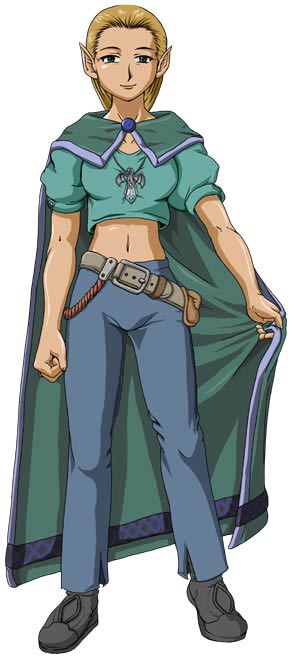|
 2.
Cel Art on the Computer 2.
Cel Art on the Computer
CG cel style artwork strives
to recreate the appearance of a traditional
animation cel. Although the process of creating cel
style artwork is often less time consuming then
other means of coloring like painting or
airbrushing, it also requires a good understanding
of color and shading. Individual shades of color
(shadows and highlights) in cel style artwork have a
well-defined edge. Since these separations sharply
contrast each other, a badly placed shadow will
stick out like a sore thumb, and can possibly ruin a
well-drawn picture.
Cel artwork created on the computer has many
benefits over cel artwork created on acetate. For
one, it's much more cost effective, as you won't
have to buy acrylic paints, paint brushes, or
acetate paper, all of which can become very
expensive purchases. Furthermore, it's much more
time consuming to create cel artwork on acetate, and
mistakes are not easily undone. Finally, it's
possible to achieve a much higher level of detail
and quality with cel style artwork on the
computer.
Most artists generally
utilize either Adobe Photoshop or Paint Shop Pro for
creating cel artwork on the computer.
I currently use Photoshop 6.1 for cel artwork, and
that's the program I'll be using while I walkthrough
the process of creating cel style artwork. Photoshop is a wonderful tool for
producing high quality works
that achieve the look of a traditional animation
cel, and much better!
3.
What should you already know?
This chapter has a
couple of prerequisites. You need to be familiar
with several other chapters first, so that your
artwork will be properly prepared for the cel art process.
First, it would be very helpful to have a basic
understanding of Photoshop's layers. The colors and the line work for your
picture will have to be placed on separate layers, so
take some time to read through that short chapter on
Photoshop layers before proceeding.
Second, the chapter on color filling, and
color choice are
suggested reading as
well. These three sections will help you set up your image for
cel coloring.
Finally, there's a chapter
dedicated to the placement of shadows and highlights that directly corresponds
to cel shading. This chapter will show you how to get the most out of
your image by carefully explaining the concept behind the
placement of lights and darks. If you have not yet read this chapter,
or any of the other chapters listed above,
do yourself a favor, and become familiar with
the concepts these sections present before proceeding into the
next cel style coloring section.
|